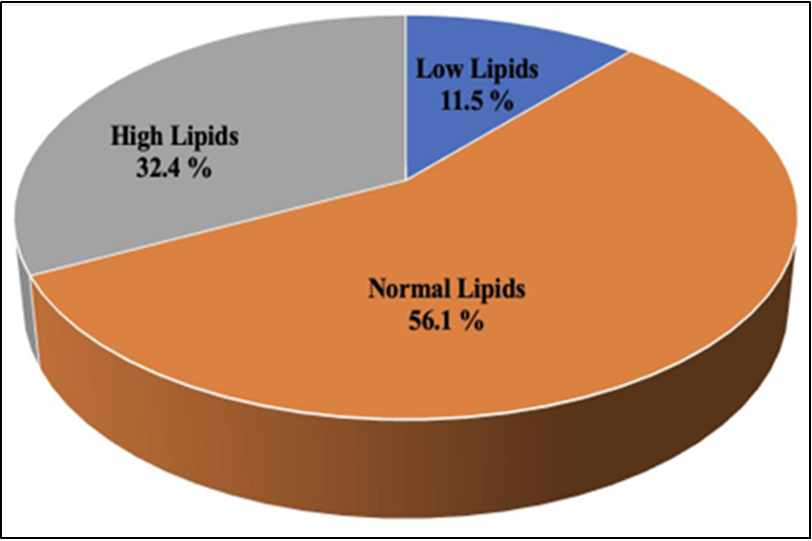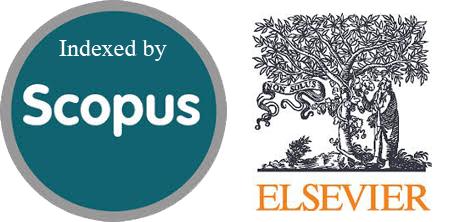Tamoxifen-Induced Dyslipidemia in Hormone Receptor-Positive Breast Cancer Patients: A Cross-Sectional Study among Kurdish Population
DOI:
https://doi.org/10.54133/ajms.v9i2.2284Keywords:
Lipid biomarkers, Hormonal positive breast cancer, TamoxifenAbstract
Background: Each patient's risk-benefit profile must be carefully assessed because tamoxifen's anti-estrogenic properties may have an impact on lipid metabolism. Objectives: This research looks into how tamoxifen affects Kurdish women's lipid profiles. Methods: This cross-sectional study was conducted at the Azadi Hematology Oncology Centre in Duhok City, Kurdistan Region, Iraq, on 165 females with estrogen- and/or progesterone-positive breast cancer receiving adjuvant hormonal therapy with tamoxifen for three months or longer. Results: The mean age was 42.4 years; 83.6% were married and multiparous (77.6%), with a BMI of 29.1 kg/m². 56.1% of participants had normal lipid profiles, 32.4% had elevated levels, and 11.5% had low levels. Age showed minimal impact on lipid biomarkers, with very weak correlations. Obese patients had normal TC (68.6%), HDL-C (68.6%), LDL-C (44.8%), TC/HDL-C (73.1%), and LDL-C/HDL-C (88.1%) ratios, as well as elevated TG (65.7%) and VLDL-C (77.6%), with weak correlations. Patients treated with tamoxifen for ≥ 24 months showed higher proportions of normal and high lipid profiles, with minimal impact of treatment duration. Conclusions: Abnormal HDL-C, TG, VLDL-C, and TC/HDL-C were more frequent in obese patients, suggesting BMI had more impact on lipid profile than age or therapy duration. Tamoxifen had limited effects on lipid profile, with minimal associations with age or treatment duration.
Downloads
References
Huang J, Chan PS, Lok V, Chen X, Ding H, Jin Y, et al. Global incidence and mortality of breast cancer: a trend analysis. Aging (Albany NY). 2021;13(4):5748-5803. doi: 10.18632/aging.202502. DOI: https://doi.org/10.18632/aging.202502
Ferlay J, Soerjomataram I, Dikshit R, Eser S, Mathers C, Rebelo M, et al. Cancer incidence and mortality worldwide: sources, methods and major patterns in GLOBOCAN 2012. Int J Cancer. 2015;136(5):E359-386. doi: 10.1002/ijc.29210. DOI: https://doi.org/10.1002/ijc.29210
Siegel RL, Miller KD, Fuchs HE, Jemal A. Cancer statistics, 2022. Cancer J Clinicians. 2022;72(1):7-33. doi: 10.3322/caac.21708. DOI: https://doi.org/10.3322/caac.21708
Ali ZA, Jasim WK, Hussein DZ, Alnaqash MA. Tamoxifen effects on the lipid profile in premenopausal women with Breast cancer: A follow up study. J FacMedi Baghdad. 2018;60(3):141-144. doi: 10.32007/med.1936/jfacmedbagdad.v60i3.4. DOI: https://doi.org/10.32007/jfacmedbagdad.v60i3.4
Brunton LL, Knollmann BC, Hilal-Dandan R, (Eds.), Goodman & Gilman's The Pharmacological Basis of Therapeutics, (13th ed.), New York: McGraw Hill Medical; 2018.
Ali S, Rasool M, Chaoudhry H, Pushparaj PN, Jha P, Hafiz A, et al. Molecular mechanisms and mode of tamoxifen resistance in breast cancer. Bioinformation. 2016;12(3):135. doi: 10.6026/97320630012135. DOI: https://doi.org/10.6026/97320630012135
Lim YP, Lin CL, Lin YN, Ma WC, Hung DZ, Kao CH. Tamoxifen treatment and the reduced risk of hyperlipidemia in Asian patients with breast cancer: a population-based cohort study. Clin Breast Cancer. 2015;15(4):294-300. doi: 10.1016/j.clbc.2015.03.005. DOI: https://doi.org/10.1016/j.clbc.2015.03.005
Saladores P, Mürdter T, Eccles D, Chowbay B, Zgheib N, Winter S, et al. Tamoxifen metabolism predicts drug concentrations and outcome in premenopausal patients with early breast cancer. Pharmacogenom J. 2015;15(1):84-94. doi: 10.1038/tpj.2014.34. DOI: https://doi.org/10.1038/tpj.2014.34
Klopp-Schulze L, Joerger M, Wicha SG, Ter Heine R, Csajka C, Parra-Guillen ZP, et al. Exploiting pharmacokinetic models of tamoxifen and endoxifen to identify factors causing subtherapeutic concentrations in breast cancer patients. Clin Pharmacokin. 2018;57:229-242. doi: 10.1007/s40262-017-0555-z. DOI: https://doi.org/10.1007/s40262-017-0555-z
Sahebkar A, Serban MC, Penson P, Gurban C, Ursoniu S, Toth PP, et al. The effects of tamoxifen on plasma lipoprotein (a) concentrations: systematic review and meta-analysis. Drugs. 2017;77:1187-1197. doi: 10.1007/s40265-017-0767-4. DOI: https://doi.org/10.1007/s40265-017-0767-4
Henderson VW, Lobo RA. Hormone therapy and the risk of stroke: perspectives 10 years after the Women's Health Initiative trials. Climacteric. 2012;15(3):229-234. doi: 10.3109/13697137.2012.656254. DOI: https://doi.org/10.3109/13697137.2012.656254
Sanchez-Spitman A, Swen J, Dezentje V, Moes D, Gelderblom H, Guchelaar H. Clinical pharmacokinetics and pharmacogenetics of tamoxifen and endoxifen. Expert Rev Clin Pharmacol. 2019;12(6):523-536. doi: 10.1080/17512433.2019.1610390. DOI: https://doi.org/10.1080/17512433.2019.1610390
Lim YZ, Wang Y, Cicuttini FM, Giles GG, Graves S, Wluka AE, et al. Obesity defined by body mass index and waist circumference and risk of total knee arthroplasty for osteoarthritis: A prospective cohort study. PLoS One. 2021;16(1):e0245002. doi: 10.1371/journal.pone.0245002. DOI: https://doi.org/10.1371/journal.pone.0245002
Lin C, Chen LS, Kuo SJ, Chen DR. Adjuvant tamoxifen influences the lipid profile in breast cancer patients. Breast Care. 2014;9(1):35-39. doi: 10.1159/000358752. DOI: https://doi.org/10.1159/000358752
Almeida S, Franken N, Zandona M, Osorio-Wender M, Hutz M. Estrogen receptor 2 and progesterone receptor gene polymorphisms and lipid levels in women with different hormonal status. Pharmacogenom J. 2005;5(1):30-34. doi: 10.1038/sj.tpj.6500272. DOI: https://doi.org/10.1038/sj.tpj.6500272
Patil V, Singhai R, Patil A. Evaluation of tamoxifen therapy in pre-menopausal and post-menopausal patients of breast cancer: A comparative study. J Res Med Educ Ethics. 2011;1(1):29-34. doi: 10.5958/j.2231 671X.1.1.008. DOI: https://doi.org/10.5958/j.2231-671X.1.1.008
Bourassa P, Thomas T, Tajmir-Riahi H. A short review on the delivery of breast anticancer drug tamoxifen and its metabolites by serum proteins. J Nanomed Res. 2016;4(2):80-87. doi: 10.15406/jnmr.2016.04.00080. DOI: https://doi.org/10.15406/jnmr.2016.04.00080
Kusama M, Miyauchi K, Aoyama H, Sano M, Kimura M, Mitsuyama S, et al. Effects of toremifene (TOR) and tamoxifen (TAM) on serum lipids. Breast Cancer Res Treat. 2004;88:1-8. doi: 10.1007/s10549-004-4384-z. DOI: https://doi.org/10.1007/s10549-004-4384-z
Gupta S, Tandon V, Kapoor B, Gupta A, Gupta G, Khajuria V. Effects of tamoxifen therapy on plasma lipid profile in patients of breast cancer. JAPI. 2006;54:183-186. PMID: 16800341.
Ali ZH, Ridha AAAA, Mosa AU, Sahib AS, Mohsin KK. Effect of tamoxifen therapy on lipid profile in Iraqi postmenopausal breast cancer woman. HIV Nurs. 2022;22(2):1373-1379. doi: 10.31838/hiv22.02.263.
Esteva F, Hortobagyi G. Comparative assessment of lipid effects of endocrine therapy for breast cancer: implications for cardiovascular disease prevention in postmenopausal women. Breast. 2006;15(3):301-312. doi: 10.1016/j.breast.2005.08.033. DOI: https://doi.org/10.1016/j.breast.2005.08.033
Cuzick J, Sestak I, Cawthorn S, Hamed H, Holli K, Howell A, et al. Tamoxifen for prevention of breast cancer: extended long-term follow-up of the IBIS-I breast cancer prevention trial. Lancet Oncol. 2015;16(1):67-75. doi: 10.1016/S1470-2045(14)71171-4. DOI: https://doi.org/10.1016/S1470-2045(14)71171-4
Singh HK, Prasad MS, Kandasamy AK, Dharanipragada K. Tamoxifen-induced hypertriglyceridemia causing acute pancreatitis. J Pharmacol Pharmacother. 2016;7(1):38-40. doi: 10.4103/0976-500X.179365. DOI: https://doi.org/10.4103/0976-500X.179365
Howard BV, Rossouw JE. Estrogens and cardiovascular disease risk revisited: the Women's Health Initiative. Curr Opin Lipidol. 2013;24(6):493-499. doi: 10.1097/MOL.0000000000000022. DOI: https://doi.org/10.1097/MOL.0000000000000022

Downloads
Published
How to Cite
Issue
Section
License
Copyright (c) 2025 Al-Rafidain Journal of Medical Sciences ( ISSN 2789-3219 )

This work is licensed under a Creative Commons Attribution-NonCommercial-ShareAlike 4.0 International License.
Published by Al-Rafidain University College. This is an open access journal issued under the CC BY-NC-SA 4.0 license (https://creativecommons.org/licenses/by-nc-sa/4.0/).











